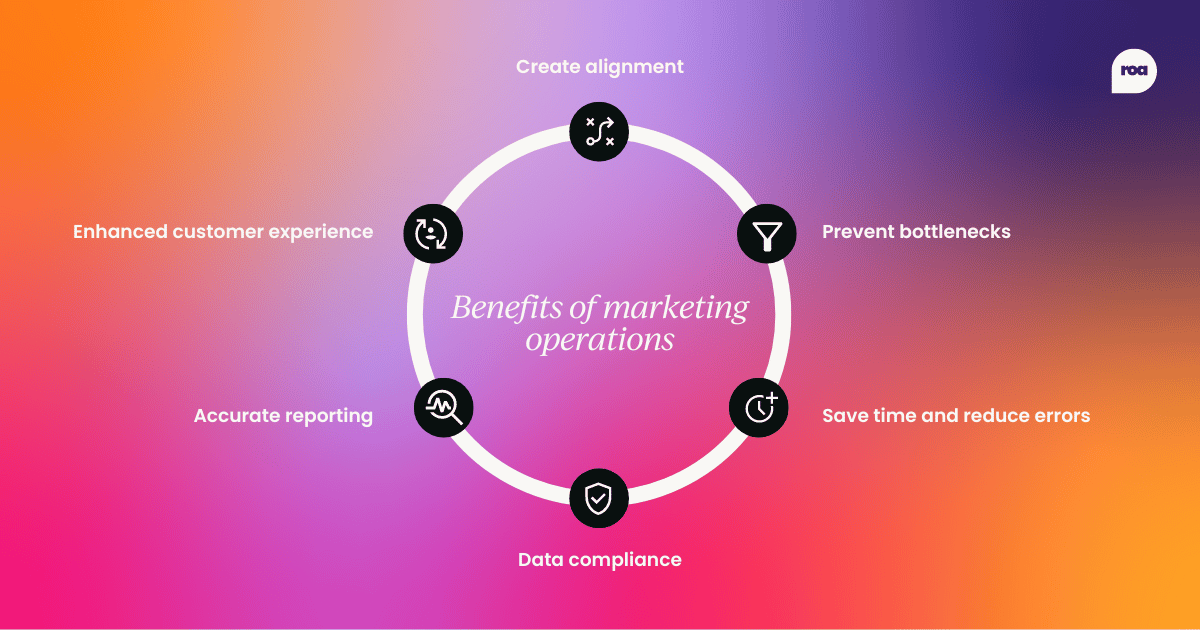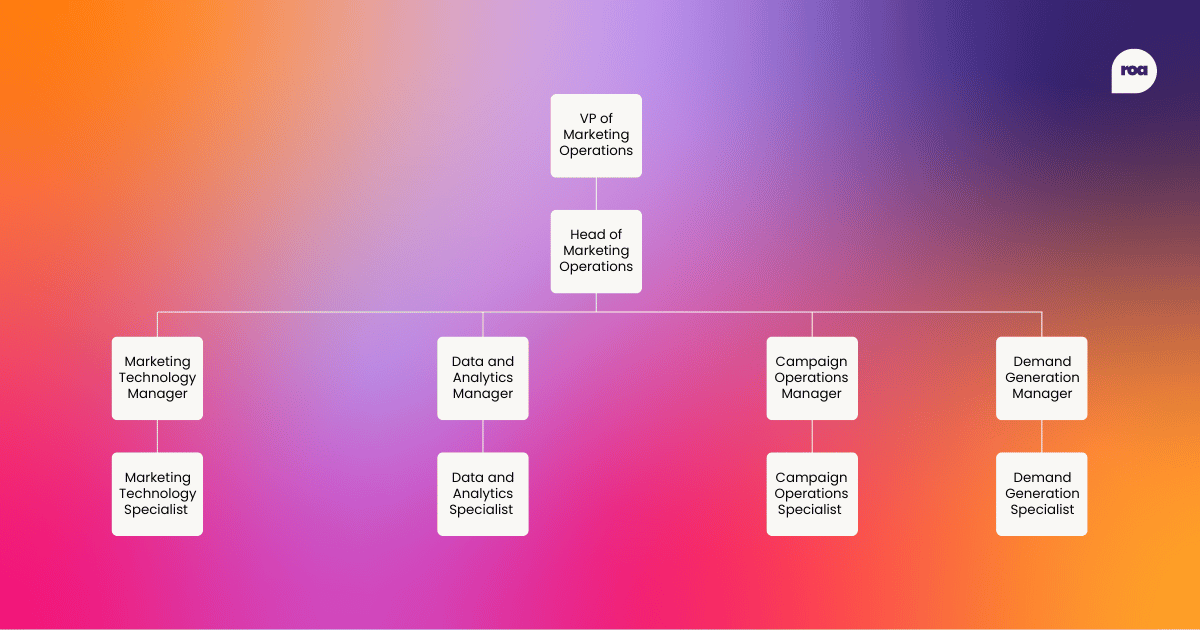Marketing operations is a function that improves marketing processes behind the scenes by managing marketing tools, automating tasks, and providing accurate reports.
This team helps to increase the productivity of your marketing team and improve results from campaigns, by supporting the marketing’s operational systems and allowing marketing executives to focus on marketing.
Looking to learn more about this business function? You’re in the right place.
This article provides you insight into:
- What marketing operations is
- The function’s benefits
- How to create a marketing ops strategy
- How to structure a marketing ops team
- The marketing operations career path
- Marketing operations vs revenue operations
What is marketing operations?
Marketing operations (also referred to as MOps or MarOps) is a marketing function that aims to streamline processes, manage tools, and provide accurate data analysis, to drive marketing efficiency.
The marketing operations team builds a solid operational foundation to reinforce and support marketing efforts and campaigns. This includes implementing and maintaining marketing tools, setting up automations, and managing projects.
Our very own Head of Marketing Operations, Andrew Cronin, said:
“Marketing operations is critical in helping marketing to be more efficient at delivering the right messages to the right people, via careful database management.
“The function helps marketing identify which channels are most effective at delivering those messages by building and maintaining a robust MarTech stack.
“Finally, marketing operations often includes a robust analytics resource that drives marketing accountability and transparency for the results they generate, including return on marketing investment (ROMI).”
Roles and responsibilities of marketing operations
There are many responsibilities of a marketing operations team, these may be split amongst a team of specialists or handled by a small group of generalists, depending on your organization. But we’ll dive into this later…
For now, here are some key roles of marketing operations professionals:
- Project management - managing and tracking long-term projects.
- Tech management - ensuring marketing tools work as expected.
- Strategic planning - informing best practices and high-level strategy for marketing efforts.
- Process development - developing and documenting efficient workflows.
- Campaign operations - building and monitoring campaigns.
- Performance measurement - measuring and reporting on key metrics.
- Data management - compliance, CRM management, and data hygiene.

Benefits of marketing operations
There are many benefits of implementing marketing operations in your marketing department. In particular, this team can optimize marketing processes, ensure better reporting, and improve your tech stack.

But first, we asked Andrew why marketing operations is so important:
“Far too often marketers are expected to manage the MarTech stack, or at least parts of it, and the team gets pulled into the weeds of how a tool works, how to get data from A to B, and making sure the 'sales-ready conversations' their campaigns have delivered are being followed up by sales.
“When, arguably, marketers need to focus on marketing. That's their expertise, their domain. Marketing operations can relieve some of that burden.
“Another great reason is: modern marketing campaigns use a complex mix of channels and messages which all drive some kind of engagement or response, which ultimately needs to end with sales conversations ASAP – this is where marketing operations excel.”
Create alignment
Marketing operations (and revenue operations, but we’ll get to that later) help to create cross-functional alignment between sales and marketing by aligning the tech stack and optimizing handover processes.
The function also allows for shared data and insights to improve your buyer persona criteria and targeting based on current customer data.
Prevent bottlenecks
Marketing ops teams work to streamline marketing processes to reduce bottlenecks and pesky red tape, meaning improved efficiency in your marketing campaigns.
An example of this might be by implementing a new email software that allows marketing managers to approve and leave comments on emails within the tool - saving your teams the back-and-forth in another tool.
Save time and reduce errors
Marketing automation can save your team time on manual, repetitive tasks and reduce human errors within your campaigns.
Automation tools can be used alongside AI to streamline marketing tasks and allow more time for high-impact creative and strategic work.

Data compliance
Within your customer relationship management (CRM) database lies a ton of customer data. This is used by marketing to send emails, and target messaging – but who’s making sure your org sticks to data compliance regulations?
Panic averted: your marketing operations team saved the day.
Marketing ops professionals ensure compliance with data protection laws, email unsubscribe requests, and maintain data hygiene within your database.
Better reporting accuracy
Tracking the success of marketing campaigns can be a challenge. But with the help of your marketing operations team KPI reporting can be made simpler.
These data wizards can build dashboards to show your campaign performance at a glance, and can dive further into the data if you spot an issue. This data analysis prowess allows you to make better-informed decisions on your marketing strategy.
Enhance customer experience
As a result of the other benefits, marketing operations can improve your customer experience (CX) as marketing teams have more time to spend on informative, and entertaining marketing campaigns.
Effective compliance also improves CX, as customers who request to unsubscribe from your newsletter will have their request honored quickly. Likewise, improved data analytics means marketing emails can be more personalized to the audience, again improving their experience.

How to create a marketing operations strategy
Each marketing ops strategy will be unique based on what you want to accomplish and how that looks within your organization. Here are five best practices to help you create a marketing operations strategy.
1. Involve stakeholders
When creating a plan for marketing ops it’s important to involve other stakeholders to ensure you solve the root problem. Sometimes the first problem you’re asked to solve isn’t really the cause. Asking ‘why’ many times will allow you to find the real problem, preventing constant firefighting on this issue.
It’s also important to involve stakeholders in potential solution planning, as marketing will be actually working with the fix, it’s important to keep lines of communication open. They might be able to flag an underlying issue early, preventing time wasted on a broken solution.
An example of a problem marketing ops may be asked to fix is: the email software your marketing team uses for campaigns is shutting down – they require a new tool to be implemented before this happens.
2. Define your objectives
Once you understand the problem at hand, it’s time to set your objectives. What would you like to achieve? Why will this be beneficial? When should this be achieved?
This will help you to define SMART goals which are specific, measurable, achievable, relevant, and time-bound. Including which KPIs will be used to track progress.
To continue our earlier example, your objectives might be to:
- Identify 3-5 email tools that might be suitable for your organization six months before your provider closes.
- Select which tool suits your company’s needs (including budget, ease of use, integrations, analytics, etc.), and complete the purchase cycle three months before your provider closes.
- Implement the new tool, connect to CRM, and train the marketing team on the new software - leading to an 80% adoption rate one month before your provider closes.
- Manage change and the new tool with weekly check-ins to gain 100% adoption as your provider closes.
- Optimize new systems and processes to achieve the same (or improved) productivity level as with the old system, by six months after the change.
3. Create a plan
Once you have a solid idea of what you need to solve and a rough idea of the solution, it’s time to hatch a plan. Think about all the steps that will need to be done and when in order for your project to be a success.
Tip: Use a project management tool to stay organized.
Once you have a project plan laid out it’s time to delegate and assign tasks to your marketing operations team (remember to consider each person’s strengths) and get started!
In our example, some tasks to assign could be:
- Define tool specifications that are required
- Research new email tools and how they fit requirements.
- Gain purchase approval.
- Transfer data and workflows to the new tool.
- Complete any email warming.
- Communicate this change and gain buy-in from marketing leadership.
- Create training materials to help manage the change.

4. Measure success
When you’re wrapped up in a project it can be difficult to step back and reflect on your objectives and accomplishments – but measuring your success is still important.
Make sure to check in against your goals and measure your progress regularly. This can help you to course correct if something goes wrong and increases accountability across your team.
In our example, we might want to measure the adoption rate of the new email software, and if it’s lower than expected, look into the reasons for change resistance.
5. Iterate
Even if you execute your plan perfectly, the solution may not hold up over time – especially if your company is growing quickly.
That’s why iterating on your plans is crucial for continued marketing operations success. Maybe the initial solution breaks down when your marketing team grows, or maybe a new tool needs to be maintained more regularly than initially thought.
Marketing ops solutions should be revisited a few times a year to see if they’re still fit for purpose. In our example, this may mean checking if your new email provider still fits your criteria every six months.

How to structure a marketing operations team
When structuring your marketing operations team, you’ll likely want to split your team members into different specializations, to become the most efficient team.
Some of these specialties include:
- Management – people management and strategy.
- Technology – managing and implementing tools and automations.
- Campaign management – building campaigns to specifications.
- Data analytics – analyzing and reporting on campaign performance.
- Demand (lead) generation – driving demand and passing leads to sales.
Some organizations may also have specialists working on marketing engineering (web development within the marketing department), or web platform management (managing the website and increasing traffic).
At the end of the day, how you structure your marketing operations team depends on the size of your organization and the priority tasks for your function. Smaller teams will require less personnel and may take on multiple responsibilities, whereas larger teams may have multiple individuals assigned to each specialty.

Marketing operations career path
There are many different job titles that fit under the marketing operations umbrella. But if you wanted a basic overview of the progression within this career (without all those specialized titles, we’ll get to those soon), here’s the rundown:
- VP of Marketing Operations
- Head of Marketing Operations
- Marketing Operations Manager
- Marketing Operations Specialist
Some other role variations might include coordinator, executive, associate, analyst, and intern, depending on the organization.
Okay, so now that we’ve got the basic progression down, let’s learn more about those specialized titles.
The progression through a specialized career path will look similar to the above but there may be more detail within your job title. This table shows examples of this career journey across some of those key specializations we discussed earlier.

But because nothing is ever straightforward when it comes to job titles, you may also find some teams use the first structure, with the specialty added on at the end. For example, Marketing Operations Manager, Technology; Marketing Operations Specialist, Demand Gen; Marketing Operations Analyst, Data and insights; and so on.
Skill set for a marketing operations manager
There are so many skills a marketing operations professional may need in their career, especially given all the specialization opportunities in the role. So we’ve highlighted six key hard and soft skills to look for:
| Hard skills | Soft skills |
|---|---|
|
|
Looking for more details? Andrew shared his thoughts on the most important skills in marketing ops:
“Curiosity and problem-solving – these go hand in hand and allow marketing operations to peel back the layers of complexity and resolve challenges.
“Expectations management skills – often marketing operations is building the plane, while flying it, and the sales and marketing teams always want more done, faster, while setting the plane on fire. If marketing operations can't firmly manage expectations people always end up disappointed.
“Database and MarTech stacks – the ability to see how decisions about the CRM and tech stack can impact new or existing processes. It's like a chess board, you need to be able to see and plan for what can happen four moves ahead in the game.”

Marketing ops advice
We asked our Head of Marketing Operations one last question: What’s your number one tip for someone working in marketing operations?
“The GTM motion depends on marketing operations to deliver more and more as it grows – it has an insatiable appetite.
“You need to be helpful, precise, and informative but also gracious when saying no, or it's not a priority right now, or we don't have the resources, etc.
“You’ll deliver lots of critical needle-moving projects which feels great to have an impact but they always want more, so be gracious, considerate, and confident when you have to disappoint – because it's going to happen.”
– Andrew Cronin, Head of Marketing Operations, The Alliance.
How do marketing operations work with RevOps?
In the past, operations teams have been separate functions adjoined to the hip of the department they support, but with the rise of revenue operations as a strategic business function marketing operations is often seen as a sub-function of RevOps.
In other words, marketing ops is one responsibility of revenue operations, alongside sales operations and customer success operations. RevOps aims to align these three ops functions to create a more efficient revenue machine.
TL;DR
- Marketing operations is a function that improves marketing processes and technologies behind the scenes, by utilizing automation, managing the CRM, and analyzing data.
- The function’s benefits include creating alignment, improving efficiency, and more accurate data insights.
- When creating a marketing ops plan it’s key to involve your stakeholders and define your objectives early.
- Marketing operations teams are often structured around functional areas to create a team of specialists.
- When combined with sales ops and customer success ops, marketing ops is a sub-function of revenue operations.



 11 min read
11 min read
 Follow us on LinkedIn
Follow us on LinkedIn




